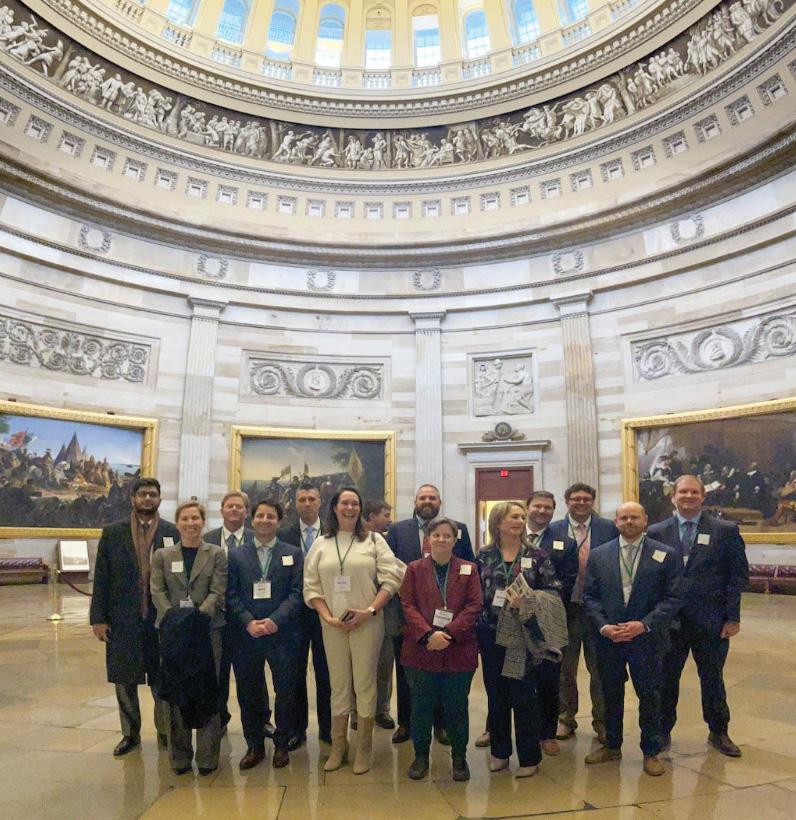Helping You Plan For Your Business
“With
 —Ken Fisher, President & CEO, AmericanHort
—Ken Fisher, President & CEO, AmericanHort


“With
 —Ken Fisher, President & CEO, AmericanHort
—Ken Fisher, President & CEO, AmericanHort

 By Neal Glatt, Managing Partner, GrowTheBench, Neal@GrowTheBench.com
By Neal Glatt, Managing Partner, GrowTheBench, Neal@GrowTheBench.com
The number one thing that employees want in a job is growth and development opportunities, and the lack of these opportunities is one of the key reasons why people leave companies. In fact, Gallup reports that 93% of the time millennial workers changed their role, they also changed their employer. This means that these workers wanted a new role, responsibility, or pay raise, but didn’t see that opportunity at their current employer.
The problem that many managers face, however, is a lack of positions available for workers to grow towards. While large companies may have plenty of open positions and growth opportunities, small and medium sized firms rarely have vacancies at the right level and the right time for employees looking to grow in their career. Talented workers who are seeking the next challenge often will look around their company and realize that vertical growth up the org chart simply isn’t an option.
When moving higher in the hierarchy isn’t an option, sometimes it can be suggested that a horizontal, or lateral, move may be the best step in an employee's career growth. And while this is occasionally true, it often fails to inspire employees to perform at their best because it can lack the pay,
responsibility, and prestige increases that a great worker desires in their career journey. Companies that cannot promote employees up to the next level and cannot inspire workers to move across to another position have a significant retention risk. For today’s workforce in these environments, switching companies to advance their career is the next logical step and will most likely occur within the next twelve months.
The solution to a lack of vertical and horizontal moves is what GrowTheBench.com has deemed Depthical Development™. Rather than focus on changing roles and responsibilities, employees can go deeper into their existing roles. These workers grow through the addition and mastery of new skills, more consistent exhibition of desired behaviors and values, and overall mastery of their position. And these promotions should carry the same weight and respect of any other promotion, including increased pay or benefits.


Consider a front-line or mid-level position at your company that has multiple employees in the same role. Some are great and some are just okay (and one or two perhaps shouldn’t even be working in that role). They all bring different value to the organization and are often even paid different wages for their contribution and experience. Yet they share the same job title and are conceptually lumped together.
This position is prime for a Depthical Development™ overhaul. First, create multiple positions that can reflect the different levels of proficiency. If the position is called “Technician” today, then tomorrow we will have “Provisional Technician,” “Junior Technician,” and “Senior Technician.” Or it could be as simple as expanding the role of “Laborer” to the roles of “Laborer 1,” “Laborer 2,” “Laborer 3,” and “Laborer 4.” The goal is to dramatically increase the number of possible positions available within the company.
Next, each position must have different knowledge, skills, and abilities assigned as requirements. Perhaps the best in a given role know how to use a specialized tool, can legally drive a company vehicle, or are able to utilize a company app for jobsite reporting. It may be that the weakest in a given role only know how to use hand tools safely and wear a clean uniform. Creating a chart of each position and the expected proficiencies documents what is required at each level.
Similarly, each increasing position should come with a different expectation of behaviors and values demonstrated. The lowest expectation may be arriving on time and treating others with respect. The highest expectation may be mentoring younger employees on the job and inspiring positivity for the whole team. The best practice here is to align the stated company values with each level in increasing expectations.

Finally, assign the required minimum experience required for each position and the pay range for each new position. Every manager and owner will gladly pay more for better employees, so this is an opportunity to standardize pay based on performance and incentivize growth with rewards. When assembled together, a company’s org chart is now three dimensional. The vertical and horizontal positions remain, yet depth is added for employees to be promoted deeper into their role. Companies that create Depthical Development™ are able to grow, promote, and reward employees faster, leading to significantly more engagement and retention.
If you want help creating Depthical Development™ at your company, contact Neal Glatt at Neal@GrowTheBench.com or come to one of his sessions at Cultivate’23 and meet him in person!
Cultivate’23 is fast approaching. Taking place July 15–18 in Columbus, Ohio, Cultivate’23 is full of opportunities for your entire team. In the meantime, start creating your Cultivate’23 social media plan and building up hype for the show.

As either an attendee or exhibitor at a Cultivate’23, creating a social media hype before you even get to the show will help you engage and connect with your audience—which is essential for sharing your message and having a lasting impact on your customers. In addition, having a large network on social media can open a lot of doors and provides the opportunity to share your products, brand, and key messages with the people who are interested.
So, how can you use Cultivate’23 to build your customer base and audience? What are some of the tried-and-true methods and newest trends? Here’s a checklist that can help you navigate how to use social media to your advantage as Cultivate’23 approaches.

This list will help you:
• Build relationships with influencers, attendees, event organizers, industry peers and other businesses
• Bring people to your booth or presentation
• Make your message memorable and impactful after the event
• Increase your number of followers and influence
• Get more customers or brand/product awareness
1. Share the Event & AmericanHort Posts About Cultivate’23
Follow AmericanHort on social media and share the Cultivate’23 event and other posts relating to Cultivate’23. Take advantage of the content AmericanHort has already created to help build your audience and let your customers know that you will be at Cultivate’23.

2. Send Personal Invitations
Use Facebook messages, Twitter direct messages, and LinkedIn messages to invite key customers, influential attendees, and industry peers to visit your booth or attend your presentation.
Make sure to tell them the why, where, and when regarding your exhibit or presentation, and invite them to connect with you. When you get positive responses, save their names in a list for the day of the event and try to meet in person or follow up with them.
3. Use Polls
Use social media to help with your event market research. Use polls in advance of Cultivate’23 to ask for opinions or find out what your potential customers want to know, then use your findings to adapt your exhibit signage, marketing support material, or game plan for exploring the show.
4. Post Teasers
Post about your new products or services and share photos or content that feature a few unique facts or features that will increase interest and attention. Remind people where they can come and see you to learn more.
5. Use Cultivate’23 Hashtags
Start using the event hashtag before you even get to the venue! Use #Cultivate23 to help your posts reach the correct people right off the bat.
6. Set Up a Resource Page
Set up a resources page with all your social media handles, your contact details, product or service information, slides, collateral material, images, important links, free resources, videos, and relevant presentations to make it easy for your customers and audience to continue learning from you. Get this ready to share with everyone you meet at Cultivate’23.
7. Share exciting moments from previous year’s Cultivate shows
For those of you that have been to Cultivate before, sharing your favorite moments from previous years and letting your audience know how much you are looking forward to creating more of these moments is an easy touchpoint. If you have photos or video, be sure to tag any customer or collaborator in the post.
There are many ways to connect and engage with your customers or audience through social media. You’ll soon find out what platforms work best for you and your business. You don’t have to participate on all of them—choose the platforms where your customers spend most of their time and focus on developing content that you can use throughout the planning cycle for attending Cultivate’23.
We look forward to seeing you soon!
WITH US
@American_Hort @AmericanHort
FedEx and UPS have increased their rates by an average of 6.9% for 2023. That’s a heavy statement for a couple of reasons. First, this is the highest General Rate Increase (GRI) the carriers have taken in recent years. And second, your actual shipping costs will likely go up more than 6.9% in the new year. Oof. Unpacking the new changes is complicated, but essential if you want to understand how your costs will be affected and what you can do about it.
A look back at the FedEx and UPS GRIs
FedEx and UPS have a long history of mirroring each other’s pricing. They typically announce the same GRI and appear to have very similar pricing strategies. Bottom line— published rates aren’t a major differentiator between the two carriers.
For 2023, both FedEx and UPS are pointing fingers at inflation as a contributing factor to the higher-than-usual rate increase. 2022 already saw an uptick with a 5.9% GRI, thanks to all of the supply chain disruptions and surges in demand that resulted from the pandemic. For several years prior to that, both carriers had been raising their rates annually by an average of 4.9%. This year, the average increase is 6.9%.
Important changes from the new FedEx and UPS rates
• Across all services and weight breaks, longer zones are getting hit with higher increases than shorter zones. Many of those increases are higher than the announced average.
• For ground services, many of the rates for shorter zones are lower than the 6.9% average increase.
• For each service, the rate increases are similar across most weight breaks. Zones are the biggest differencemakers this year.
• For the 3 Day services, you’ll see a higher increase from FedEx than UPS. However, the actual rates are
comparable. That is because UPS took a larger increase with this service the previous year.
• Both FedEx and UPS have increased their Ground Minimum charge to $10.10
When you are reviewing your shipping costs, you can’t look at the base rates alone. Surcharge fees often make up a significant chunk of the amount you end up paying. Here are a few noteworthy surcharge updates:
• Fees for larger, more difficult to move packages continue to rise to hefty prices. You could be paying an extra $1,150 for a shipment that qualifies for the Unauthorized Packages fee by FedEx or the Over Maximum Limits fee by UPS.
• Both carriers are increasing the late payment fee from 6% to 8%.
• FedEx created a Remote Delivery Surcharge. Almost 4,000 zips will now incur a $13.25 fee. UPS originally introduced a fee for this in January 2022.
• Many common surcharges are increasing, with a significant amount increasing by more than 6.9%.
How the FedEx and UPS rate changes will affect your costs in 2023
You can’t take the announcement of a 6.9% increase at face value, unfortunately. You’ll need to determine what services you
use the most, how far your shipments travel on average, and how much of your invoice charges can be attributed to fees.
Many shippers will see their costs go up over the announced 6.9% average. With that in mind, let’s look a few factors that could put you at risk for higher-thanaverage cost increases:
• If you’re shipping larger packages or your packages require special handling. For the past several years, FedEx and UPS have been raising these fees at an alarming rate. Any shipment they can’t run through their normal systems costs them more time and money, and these fees are a way to discourage those types of shipments from entering their networks.
• If you ship a higher percentage of residential shipments. Residential shipments cost the carriers more because they require more stops and are a less efficient use of their driver’s time. Residential fees continue to climb because of this.
• If you ship a lot of low density packages. The pricing structure that FedEx and UPS have put in place punishes lighter shipments that take up a lot of space. The carriers prefer denser packages that take up less space because they’re able to fit more packages on their delivery vehicles.
• If a high percentage of your shipments go to longer zones. It’s always been true that the further your package travels, the more expensive the rate. This year that’s especially true. Longer zones are seeing more increases above the announced average than shorter zones.
What you can do to mitigate the effects of the FedEx and UPS rate increases
• Right-size your packaging. While FedEx and UPS rates are based on weight, that’s not actually the whole story. If your dimensional weight is higher than the actual weight, your package will be rated using the dimensional weight—meaning you’ll be paying more. This makes any excess space within your package extra costly. Focus on packaging that allows space for the items you’re shipping and the

AmericanHort members save on shipments with TForce Freight, YRC, XPO, Saia, and many others. These competitive rates are made available through our endorsed shipping provider, PartnerShip®
Save on FedEx shipping through the AmericanHort affinity partner program. Members receive 45% off FedEx Express and 25% off FedEx Ground. If you currently ship with FedEx, you’ll be able to continue using it the same way you do today.

Email Hello@AmericanHort.org for more information about either of these affinity partner programs.
necessary cushioning and nothing more.
• Consider opening or using a new distribution center. Shipments with the longest distance to travel cost you the most every year. But in 2023, this will be even more important as the longest zones are seeing the highest increases. Getting closer to your customers could be a great strategy for keeping those costs down.
• Take advantage of discounts available to you. Many trade associations and chambers of commerce will offer FedEx or UPS discounts to their members. Oftentimes the annual cost savings from those discounts more than make up for the cost of joining. PartnerShip works with over 130 groups to provide their members with discounts on FedEx services. As an AmericanHort member, you qualify for these discounts.
Wrapping your head around all of the changes for 2023 FedEx and UPS rates can be challenging. But, using this guide to understand what’s behind the announced average and published service guides is a good first step. Use this information to properly budget for the new year and set up any mitigation tactics that work best for your business.
The 2023 funding allocations for Plant Protection Act’s Section 7721 (PPA 7721) were recently announced.
Plant Protection Act’s Section 7721, initially established in the 2008 Farm Bill as the Plant Pest and Disease Management and Disaster Program and revised in the 2014 Farm Bill to the Plant Protection Act. Annually PPA 7721 provides $75 million to fund projects meant to strengthen the Nation’s infrastructure for pest detection, surveillance, and identification; threat mitigation; safeguarding the nursery production system; and responding to plant pest emergencies.
For 2023, USDA is funding 322 projects conducted by universities, States, Federal agencies, nongovernmental organizations, non-profits, and Tribal organizations carried out in 48 States, Guam, and Puerto Rico. Many of these projects were encouraged and supported by AmericanHort as a direct result of our interactions with the industry. Three AmericanHort advocacy and research staff team members participate in the national evaluation of PPA 7721 proposals, allowing AmericanHort direct input on which projects to prioritize.
Of particular importance is over $900,000 allocated for Box Tree Moth (BTM) response initiatives, including continued pest management, biological control, outreach, and survey work for BTM. These efforts should provide the foundation for near-term boxwood plant certification, and longer term landscape-scale mitigation of BTM.

Vascular Streak Dieback (VSD) was also an important proposal topic, with several research-oriented projects being sponsored as well as a regional survey for VSD.
Another project that AmericanHort helped to coordinate seeks to streamline and improve the systems approach for geranium (Pelargonium) offshore-produced cuttings, ultimately leading to a more efficient supply chain.


We will be reporting on projects and progress in the weeks and months ahead.
In January, the U.S. Department of Agriculture (USDA) announced the availability of $72.9 million through the Specialty Crop Block Grant Program (SCBGP) to fund innovative projects designed to support the expanding specialty crop sector and explore new market opportunities.
USDA’s Agricultural Marketing Service (AMS) accepts applications for the grant program until May 1, 2023.
Throughout the years, SCBGP funds have supported a wide array of projects in the horticultural industry, such as regionally focused education and promotion campaigns in Arizona, Colorado, Massachusetts and elsewhere, research related to protecting pollinators in ornamental plant production in North Carolina, and mitigation practices to stop the spread of pests in Oregon.


Learn how to apply on the AMS SCBGP webpage:
ams.usda.gov/services/grants/scbgp

AmericanHort welcomed the inaugural class of the Horticultural Research Institute Leadership Academy to Washington on January 17–19, for the third of four faceto-face meetings. In addition to the core focus on leadership and management skills, this Washington meeting was an ideal opportunity to expose the 14 rising leader class members to advocacy and the public policy process.
Civic and political engagement are important aspects of leadership. The session sought to demystify how the policymaking process works, and what emerging leaders can do to positively impact outcomes for our industry. Class members commented after how impressed they were at the speaker lineup and insights shared. Several remarked that it was refreshing to hear two chiefs of staff talk at length about their openness to working on a bipartisan basis to address the needs of their constituents and districts (despite what gets reported in the media). Another commented that prior to the dialogue, he “presumed EPA is the enemy.” He came to appreciate the important role EPA plays registering crop protection tools critical to our industry, while often operating in the face of criticism and even litigation from all sides.

AmericanHort and the Horticultural Research Institute (HRI) are committed to helping green industry businesses perform better, grow faster, and prepare for the future. A healthy and robust industry is one with connected leaders that have a positive impact on their businesses, their industry, and their communities.
Partnering together, AmericanHort and HRI have created the HRI Leadership Academy, an advanced program designed for rapid leadership development and real-world results. Strong leaders and strong ongoing leadership development are mission critical for green industry businesses.
Managed through HRI and generously supported by AmericanHort, the HRI Leadership Academy addresses the industry’s need for a leadership development program that serves both current and future leaders through training, coaching, and access to a growing network of industry leaders.
HRI Leadership Academy Program
Graduates Will Gain:
• Ability to view their business and its opportunities and challenges holistically
• Improved leadership and people management skills and an ability to motivate others
• Ability to effectively manage complex issues and challenges with confidence
• Ability to transform vision into action
• Continued growth through participation in a broader industry network of leaders
Do you know a rising star in our industry who should apply for the upcoming 2023–24 HRI Leadership Academy Class? Encourage them to apply for the program.
Applications are due March 1. Visit HRILeadershipAcademy.org to learn how this program is developing leaders on all levels.

AmericanHort is seeking passionate people to guide, support, and lead the industry by sitting on the AmericanHort Board of Directors. These are the people behind the plants who share both time and talent to help the industry grow, evolve, innovate, and prepare for the best future possible.
The Board is made up of business owners and experienced senior business leaders. AmericanHort strives to find board members who have broad industry experience and knowledge, represent diverse industry segments, and have demonstrated a deep commitment to help our industry prosper. This group of passionate leaders are responsible for governing the direction and activities of AmericanHort, as outlined in our strategic plan. Members of the board serve three-year terms and meet several times throughout the year.
The formal role of the board of directors is to
provide continuity for the organization by:
• Establishing and reviewing the budget, strategies, and goals of AmericanHort
• Overseeing the business and affairs of AmericanHort considering emerging risks and opportunities
• Overseeing, selecting and maintaining a succession plan for the position of Chief Executive Officer and key members of management
Help us unite and strengthen horticulture businesses by nominating an AmericanHort member that is a leader in the industry or applying yourself.
Questions? Contact AmericanHort at Hello@AmericanHort.org or immediate past chairman of the board, Cole Mangum, Bell Nursery, at Cole@BellNursery.com.
AmericanHort’s board of directors approved the association’s 2022–24 Strategic Plan to provide a roadmap for the advancement of the association.


Made up of five goals, this two-year plan is used to help guide the organization’s operations and resource allocation decision-making to ensure that actions and investments align with the association’s mission, values, and strategic direction.
See AmericanHort’s strategic plan at AmericanHort.org/StrategicPlan.

HRI held its annual winter donor recognition reception in conjunction with MANTS’23 in Baltimore, MD in January. Over 150 supporters joined the event to honor HRI’s impact and accomplishments and raise funds to support future growth.
The reception recognized more than $350,000 in donations received prior to the end of the year and during the reception. These critical funds will support research fostering business-building knowledge for the horticultural industry and scholarships for students pursuing careers in the green industry.
Of note, several new named funds were added to the endowment. Jim Eason, Eason Horticultural Resources, Ft. Wright, KY announced the establishment of a named fund in honor of his family. Alan Jones, Manor View Farms, Monkton, MD, announced the creation of a new scholarship fund in honor of his family and business. Mark and Jolly Krautmann of Heritage Seedlings and Liners, Salem, OR, were also present to announce their gift of $25,000 to honor the many people and relationships they have fostered in what Mark calls the craft of horticulture. They challenged the room to match their gift and within minutes another $15,000 was raised for the Craig Regelbrugge—Advocates for Horticulture Fund.
Monies raised from the donations made during events like this, and throughout the year, fund the activities of the Horticultural Research Institute’s research and scholarship programs, along with educational outreach activities for the organization.
For information about HRI, or to financially support the work, please visit HRIResearch.org or contact Jennifer Gray at (614) 884-1155.
&
In each issue of Connect, we’ll be “hiding” a new small graphic. When you find it, email us at ConnectSeekAndFind@AmericanHort.org, and tell us where you found it.

For this issue, respond by March 1.
Congratulations to last issue’s winner!
Jen Gerger, Meadowood Enterprises
The Horticultural Research Institute (HRI) announces nearly $400,000 in grant support for 11 projects to tackle green industry issues ranging from pest management to new technologies, from developing marketing insights to battling plant diseases.
“Research is essential to accelerating business growth,” said Brian Decker, HRI board president and president of Decker’s Nursery, Groveport, Ohio. “HRI is committed to supporting research in the priority areas of quantifying plant benefits, creating innovative solutions, gathering consumer insights, and producing practical and actionable solutions. The projects selected through our competitive grants program for funding this year meet the unique needs of the horticultural industry—and will provide solutions and knowledge that can help grow businesses.”
The Horticultural Research Institute’s mission is to direct, fund, promote and communicate horticulture research. Supporting research that challenges current methods and bridges the divide between businesses and the consumer is exactly how HRI helps build prosperous businesses, advance the green industry and fulfill its core vision.
“The 2023 investment in each of these projects is intended to improve and strengthen the industry,” said Jennifer Gray, HRI administrator. “Research is critical to the future of our industry, and thanks to the support of our dedicated donors, HRI is able to fund promising research and researchers every year.”
Descriptions of the projects can be found on HRIResearch.org.
• Assessing the Effectiveness of Marketing Strategies of Native Plants: A. Rihn, University of Tennessee
• Categorizing and Summarizing the Environmental and Ecological Benefits of Plants: M. Knuth, North Carolina State University
• Use of Drones in Nursery IPM Programs for Agro-Chemical Application and Monitoring Plant Health: S. Gill, University of Maryland
• Pulse Electricity as a Fumigant Alternative Nonchemical Preemergence Weed Control in Seedling Beds: M. Moretti, Oregon State University
• Combating the vector of rose rosette disease: I. Tzanetakis, T. Druciarek, University of Arkansas
• Creating new genetic resources toward preventing rose rosette virus infecting roses: J. Verchot, Texas A&M University
• Periodical Cicada: Study of potential controls for the Tennessee Nursery Industry: D. Airhart, M. Bowombe Toko, Tennessee Technological University
• Coordinating a National Response to Low Fertility Cultivars of Invasive Nursery Crops: R. Contreras, Oregon State University
• Beauty is only skin-deep (Latent Fruit Rot of Winterberry): F. Hand, The Ohio State University
• Copper-based nanoparticles (Cu-NPs) in the management of boxwood blight: S. Kodati, Connecticut Agricultural Experiment Station
• Assessing Mouse Ear Disorder of Emerging Nursery Crops: B. Miller, University of Minnesota
Did you know that AmericanHort provides articles, webinar recordings, on-demand education, and more in the online Hort Knowledge Center? And it's available complimentary to all AmericanHort members.
Check out the top 10 Knowledge Center articles accessed in 2023:
• Market Metrics Index of Prices Paid by Growers Report
• Pricing to Win Series
• Vaccines, Plants and Dollars—A Year in Review
•
SNEAK PEEK: Input Cost Pressures Continue in 2022
• State of the Industry—November 2022
• Industry Insider: Supply and Inflationary Pressures
• Nursery Archives
• 5 things to think about BEFORE you apply for foreign workers
• Gearing Up for Spring: Back to Basics
• Survey Results Send a Clear Message: The Green Industry Needs Agricultural Workforce Reform
To read these popular articles, head to the AmericanHort Knowledge Center at AmericanHort.org/KC and type their titles into the search bar.
AmericanHort’s three-part Mastery Series provide an opportunity to really dig into the subject matter with leading industry experts. There are multiple Mastery Series now available on-demand that will let you walk away with immediately applicable tools and plans for your business.
Check out these Mastery Series
Available On-Demand:
• Marketing Mastery Series
• Inventory Management Mastery Series
• E-Commerce Mastery Series
• Visual Merchandising Mastery Series
• Biophilic Design Mastery Series
• Succession and Exit Planning Mastery Series
These on-demand Mastery Series are available to AmericanHort members for $99 per class and $199 per class for non-members.

Learn more at AmericanHort.org/Mastery.
When your company is an AmericanHort member, all of your employees are members too. Be sure to update your member profile on AmericanHort.org to include your employees so they can access these resources and member benefits.
Forecasting Mastery Series
A three-class series presented by: Ken Lane, President, Hathaway & Lane Direct, LLC
March 7–9, 2–3:30 PM, ET
Diagnosing Plant Problems: A Look Through the Lens of a Technical Specialist
AmericanHort webinar presented by George Grant, Technical Specialist Supervisor, Griffin
April 4, 2–3:30 PM, ET
April Women in Horticulture Interview
Interviewing Dr. Deborah Streeter, Cornell University
April 13, 2 PM, ET
In-store vs. E-commerce: Using Different Channels to Engage Consumers and Encourage Plant Sales
AmericanHort webinar presented by Dr. Alicia Rihn, Assistant Professor, Agricultural & Resource Economics, University of Tennessee
April 20, 12–1:30 PM, ET

5 Secrets to Creating Outdoor Spaces for Connection
AmericanHort Webinar presented by Lynn Kuhn, Landscape Architect, Soon-to-be-Author, and Conversation Ambassador, Conversation Gardens
May 20, 2–3:30 PM, ET
June Women in Horticulture Interview
Interviewing Kariné Stuimer, Senior Vice President, BrightView Landscape Services
June 7, 2–3 PM, ET
The Green Industry’s Must-Attend Event
Hosted by AmericanHort
July 15–18, Columbus, Ohio
Pre-Registration takes place
February 13–24
AmericanHort is the national association of horticulture businesses and professionals across the spectrum of the industry.
Perform better, grow stronger, and prepare for the future as a member of AmericanHort, the green industry’s leading association. AmericanHort.org
AmericanHort Connect
2023: February
Hello@AmericanHort.org
2130 Stella Court
Columbus, Ohio 43215-1033 USA
(614) 487-1117 Main
©2023 AmericanHort. All rights reserved. This material may contain confidential information and it is for the sole use of AmericanHort members. The information contained herein is for general guidance and not for the purpose of providing legal advice. It cannot be distributed, reprinted, retransmitted, or otherwise made public without prior written permission by AmericanHort. Please contact the editor at (614) 487-1117 for permission with acknowledgment.
2130 Stella Court Columbus, OH 43215 USA (614) 487-1117
AmericanHort.org

Electronic Service Requested Segment message here
Do you want the best selection and price for hotel accommodations at Cultivate’23?
Take advantage of Pre-Registration, open February 13–24. How Pre-Registration works:
Book your hotel rooms on your assigned date, March 6–10 from 10 AM–10 PM, ET daily, using the link provided in your email or registration dashboard.
•
You can register ANY TIME between February 13 at 8 AM, ET through February 24 at 5 PM, ET.
•
Register yourself and/or your team at AmericanHort.org/Cultivate
•
•
Check your confirmation email or registration dashboard for your assigned day to select hotel rooms.*
•
AmericanHort.org/ Cultivate
* Hotel booking date assignments are based on membership or exhibitor status. Learn more at: